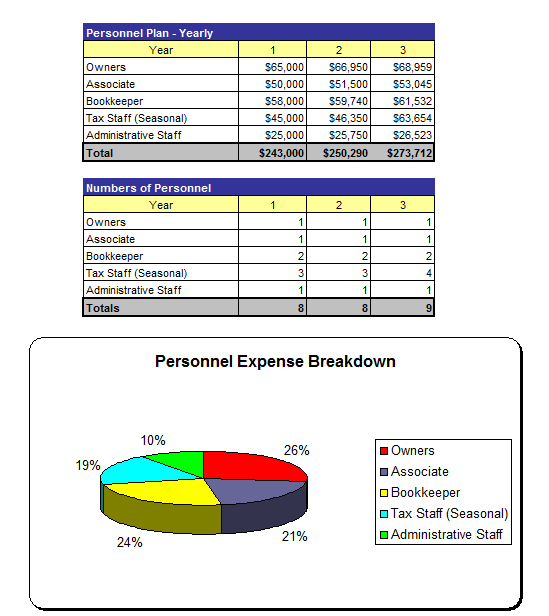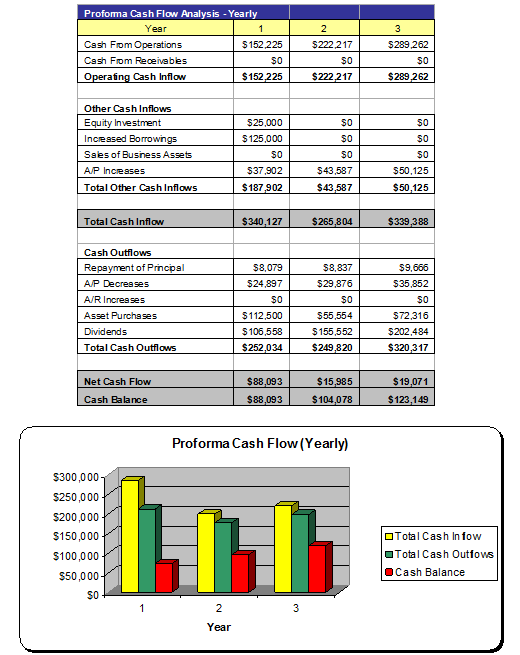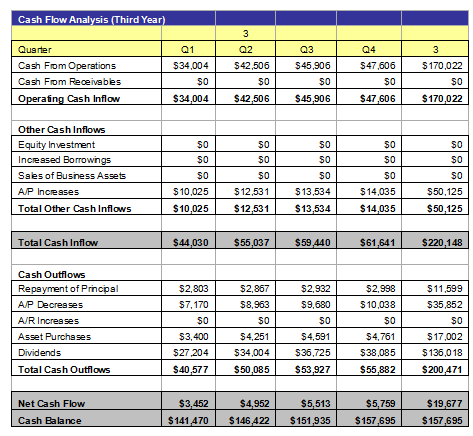Free Power Plant Business Plan
For Raising Capital from Investors, Banks, or Grant Companies!
Please note that the financials
in this complete free business plan are completely fictitious and may not
match the text of the business plan below. This free business plan demonstration
purposes only. If you are interested in purchasing the completed editable MS Word
and Excel documents for this business plan, please click the button below! Also,
the text of the business plan is formatted with a fully automated
table of contents.
Return to
Samples Page
It should be noted that there is no special software required to use these
templates. All business plans come in Microsoft Word and Microsoft Excel format.
Each business plan features:
- Excecutive Summary
- Company and Financing Summary
- Products and Services Overview
- Strategic Analysis with current research!
- Marketing Plan
- Personnel Plan
- 3 Year Advanced Financial Plan
- Expanded Financial Plan with Monthly Financials
- Loan Amortization and ROI Tools
- FREE PowerPoint Presentation for Banks, Investors,
or Grant Companies!
1.0 Executive Summary
The purpose of this business plan is to raise $10,000,000 for the development of an energy producing business that produces electricity from coal firing while showcasing the expected financials and operations over the next three years. The Power Plant, Inc. (“the Company”) is a New York based corporation that will sell electricity into the power grid from the power produced from its clean coal burning furnaces. The Company was founded by John Doe.
1.1 Products and Services
As the prices of fuels has skyrocketed (oil, natural gas, and coal), the demand among consumers for economically viable alternatives has increased. As of mid 2012, the prices of crude oil and its related energy products has almost doubled. As such, companies like Power Plant, Inc. have recognized a tremendous opportunity to develop facilities that produce electricity from coal firing. The Company intends to operate a small coal firing power plant that will produce approximately 4 to 5MW of electricity. This electricity will be then resold into the power grid as allowed by national law. The third section of the business plan will further describe the services offered by the Power Plant.
1.2 The Financing
Mr. Doe is seeking to raise $10,000,000 from an investor. The preliminary terms of this agreement call for an investor to receive an ownership interest in the business coupled with a recurring stream of dividends starting in the first year of operations. The investor will also receive a seat on the board of directors. The financing will be used for the following: • Development of the Company’s Power Plant location. • Financing for the first six months of operation. • Capital to purchase clean coal fired turbines.
1.3 Mission Statement
Management’s mission is to develop the Power Plant into a profitable venture that will provide the Company and its owners with a steady stream of income from the sale of energy productions services.
1.4 Mangement Team
The Company was founded by John Doe. Mr. Doe has more than 10 years of experience in the energy industry. Through his expertise, he will be able to bring the operations of the business to profitability within its first year of operations.
1.5 Sales Forecasts
Mr. Doe expects a strong rate of growth at the start of operations. Below are the expected financials over the next three years.

1.6 Expansion Plan
The Founder expects that the business will aggressively expand during the first three years of operation. Mr. Doe intends to aggressively solicit additional rounds of capital will concurrently reinvesting a significant portion of the Company’s after tax income into the acquisition of new locations.
2.0 Company and Financing Summary
2.1 Registered Name and Corporate Structure
Power Plant, Inc. The Company is registered as a corporation in the State of New York.
2.2 Required Funds
At this time, the Power Plant requires $10,000,000 of investor funds. Below is a breakdown of how these funds will be used:

2.3 Investor Equity
This will be further discussed during negotiation.
2.4 Management Equity
This will be further discussed during negotiation.
2.5 Exit Strategy
The Management has discussed and planned for three possible exit strategies. The first strategy would be to sell the Company to a larger entity at a significant premium. Since, the energy industry maintains a very low risk profile once the business is established, the Management feels that the Company could be sold for ten to fifteen times earnings. The second exit scenario would entail selling a portion of the Company via an initial public offering (or “IPO”). After a detailed analysis, it was found that comparable companies sell for twenty times earnings on the open market. However, taking a company public involves significant legal red tape. Power Plant, Inc. would be bound by the significant legal framework of the Sarbanes-Oxley Act in addition to the legal requirements set forth in form S1 of the Securities and Exchange Commission. The Company would also have to comply with the Securities Act of 1933 and the Exchange Act of 1934. The last exit scenario would involve the use of a private placement memorandum to raise capital from private sources. This is also a significantly expensive process that requires the assistance of both an experienced securities law firm and an investment bank. Funds would be raised from private equity and merchant banking sources in exchange for a percentage of the Company’s stock.
3.0 Products and Services
As mentioned in the executive summary, the Company is seeking to develop a coal based energy production facility that will produce 4 to 5 megawatts of limited emission electricity. The retail energy price of electricity is $.09-14 KWh, which is what residential customers pay on average within the United States. Wholesale pricing is lower than that based on the utilities expenses and profits. Management believes $.045 - $.06 per KWh is possible price that the Company can sell its energy to the local utilities and municipalities
4.0 Strategic and Market Analysis
4.1 Economic Outlook
This section of the analysis will detail the economic climate, the energy industry, the customer profile, and the competition that the business will face as it progresses through its business operations. The current geopolitical environment has led Management to believe that energy prices will continue to increase in the near future. The general Middle Eastern instability has led many economists to believe that there is a fifteen to twenty percent risk premium now associated with the price of crude oil and related energy products. While these issues bring worry to the general economy, Management sees a significant opportunity to enter the market with a source of alternative energy. Many politicians and special interest groups have promoted the development of alterative energy solutions to combat the continually increasing energy prices in the United States. Additionally, the fast growth of Asian nations (namely India and China) has prompted further increases in the global demand for energy. This trend is expected to continue in perpetuity. Inflation is also concern for the Company. As the inflation rate decreases, the purchasing power parity of the American dollar decreases in relation to other currencies. This may pose a significant risk to the Company should rampant inflation, much like the inflation experienced in the late 1970s, occur again. In this event, the Company will enlist the services of a qualified derivatives focused investment bank to manage large scale currency transactions that would offset the risks normally associated with the distribution of energy products to foreign buyers. The primary risk of rapid inflation in the economy would contribute to a slow down in spending among consumers, but it would also effect the Company’s ability to borrow funds for the expansion of the number of clean coal fired turbines operated by the business.
4.2 Industry Analysis
There are approximately 400 energy companies that provide power generation to the general public. Each year, these businesses aggregately provide more than $450 billion dollars of energy to the open market. The trend among these alternative energy sources is expected to grow significantly as the need for fuels and power grows. Currently, the price of oil and other fossil fuels has skyrocketed to the point where many consumers are looking for alternative methods of power. Collectively, the industry employs more than 250,000 people. Aggregate payrolls exceed $50 billion dollars per year. The industry is expected to grow by 10% per year over the next five years.
4.3 Customer Profile
For the Company’s electricity production capabilities, Management expects two core groups of purchasers: government agencies and electricity wholesalers. Among the first group, Management expects that agencies such as counties, state governments, and the US federal government will acquire large scale electricity delivery contracts from the Company with the intent to use the energy within their large scale applications. At the onset of operations, the Company will immediately begin developing relationships with local county governments as well as the state government for ongoing divestiture and purchase agreements.
4.4 Competitive Analysis
Energy production is one of the most free markets in the economy. These markets operate on a global scale, and as such, it is difficult to determine the exact competitors that the Company will face as it progresses through its business operations. Any business that produces electricity is a potential competitor for the business. However, clean coal fired energy is becoming an increasingly popular method of producing electricity, and the Company’s primary competitive advantage will be its low cost operating infrastructure, its and the demand among consumers for cleaner alternatives to traditional oil, natural gas, and nuclear energy power plants.
5.0 Marketing Plan
As the Power Plant intends to sell its produced energy directly into the electrical grid, the marketing required by the business will be minimal. However, Management is committed to increasing the awareness of clean coal energy usage. Below is a brief overview of the ways that the Power Plant will market its operations and alternative energy production.
5.1 Marketing Objectives
-
• Establish relationships with energy wholesalers and government agencies within the Company’s targeted market.
-
• Develop an online presence by developing a website and placing the Company’s name and contact information with online directories to further increase awareness of coal produced energy.
-
5.2 Marketing Strategies
Currently, there are a number of organizations, including the American Coalition for Clean Coal that are pushing initiatives, lobbying legislatures, and informing the general public about the benefits about coal energy products. Management feels that it is important to invest in these public relations campaigns (even though they will not effect direct sales). Additionally, the increased awareness of clean coal produced electricity, its limited emissions, and ability to wean the United States off of foreign energy sources may prompt consumers and lawmakers to further expand the rebates, tax credits, and other incentive programs available for making clean coal produced electricity an economy viable energy product now and in the future. Approximately $10,000 to $20,000 per year will be spent to support these causes. Additionally, industry conventions, energy product trade shows, and other public relations campaigns will be enacted in order to promote the understanding of clean coal electricity to the general and business public.
5.3 Pricing
In this section, describe the pricing of your services and products. You should provide as much information as possible about your pricing as possible in this section. However, if you have hundreds of items, condense your product list categorically. This section of the business plan should not span more than 1 page.
6.0 Organizational Plan and Personnel Summary
6.1 Corporate Organization

6.2 Organizational Budget

6.3 Management Biographies
In this section of the business plan, you should write a two to four paragraph biography
about your work experience, your education, and your skill set. For each owner or
key employee, you should provide a brief biography in this section.
7.0 Financial Plan
7.1 Underlying Assumptions
-
• The Power Plant will have an annual revenue growth rate of 5% per year.
-
• The Owner will solicit $10,000,000 of equity funds to develop the business.
-
• The Company will invest 25% of its after-tax profits back into the Company’s operating infrastructure.
7.2 Sensitivity Analysis
The Company’s revenues are moderately sensitive to changes in the general economy. Clean coal product electricity is comparatively priced with their petroleum based counterparts, and in the event that prices decline, the Company may see a reduction in its revenues. However, the price of oil is expected to continue to climb as reserves are limited and the price of oil has increased significantly over the last two years. Only in the event of a steep drop in the price of petrol based energy products does Management anticipate that the Company will have issues regarding top line income.
7.3 Source of Funds

7.4 General Assumptions

7.5 Profit and Loss Statements

7.6 Cash Flow Analysis

7.7 Balance Sheet
 .
.
7.8 General Assumptions

7.9 Business Ratios

Expanded Profit and Loss Statements




Expanded Cash Flow Analysis



